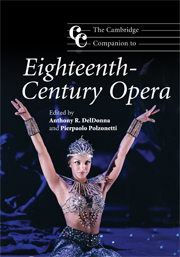Book contents
- Frontmatter
- Part I The making of opera
- 1 Opera as process
- 2 Aria as drama
- 3 Ensembles and finales
- 4 Metastasio: the dramaturgy of eighteenth-century heroic opera
- 5 Roles and acting
- 6 Ballet
- 7 Orchestra and voice in eighteenth-century Italian opera
- 8 To look again (at Don Giovanni)
- Part II National styles and genres
- Notes
- Bibliography
- Index
5 - Roles and acting
from Part I - The making of opera
Published online by Cambridge University Press: 28 September 2011
- Frontmatter
- Part I The making of opera
- 1 Opera as process
- 2 Aria as drama
- 3 Ensembles and finales
- 4 Metastasio: the dramaturgy of eighteenth-century heroic opera
- 5 Roles and acting
- 6 Ballet
- 7 Orchestra and voice in eighteenth-century Italian opera
- 8 To look again (at Don Giovanni)
- Part II National styles and genres
- Notes
- Bibliography
- Index
Summary
The eighteenth century can be described as the epoch of “Theater and Revolution” and the two are not completely unrelated. Italian theater, primarily opera, played a fundamental role in the establishment of contemporary “show business” and in the dissemination of ideas across social classes and nations. Comic opera was not a new genre, but it did represent a modern artistic and economic phenomenon, which involved the collaboration of musicians (whether composers, singers, or instrumentalists), librettists, architects, set and costume designers, impresarios, publishers and many other professional disciplines (as outlined in the first chapter of this volume). The hierarchical organization of the dramatic roles became more prevalent and it influenced not only the casting of an opera, but also structure and content, whether serious or comic. Although serious opera roles reflected primarily the virtuosic qualities of the singers, comic roles required a rich variety of skills, namely acting and singing were merged together, and had a particular importance to the plots. The Baroque conception of theater generated the star-system in Italy with strict lines of demarcation between leading roles and secondary roles. Surviving documents, mainly contracts for singers, illustrate a burgeoning and bureaucratic phenomenon on the Italian peninsula, which produced hundreds of operas performed in the major cities (Venice, Naples, Milan, Turin, Florence, Bologna, Rome) and in outlying areas of the country. The hierarchical organization of roles also reflected the economic growth of comic opera, which increasingly required a form of organization to “classify” the various components of a cast.
- Type
- Chapter
- Information
- The Cambridge Companion to Eighteenth-Century Opera , pp. 85 - 98Publisher: Cambridge University PressPrint publication year: 2009
- 1
- Cited by



